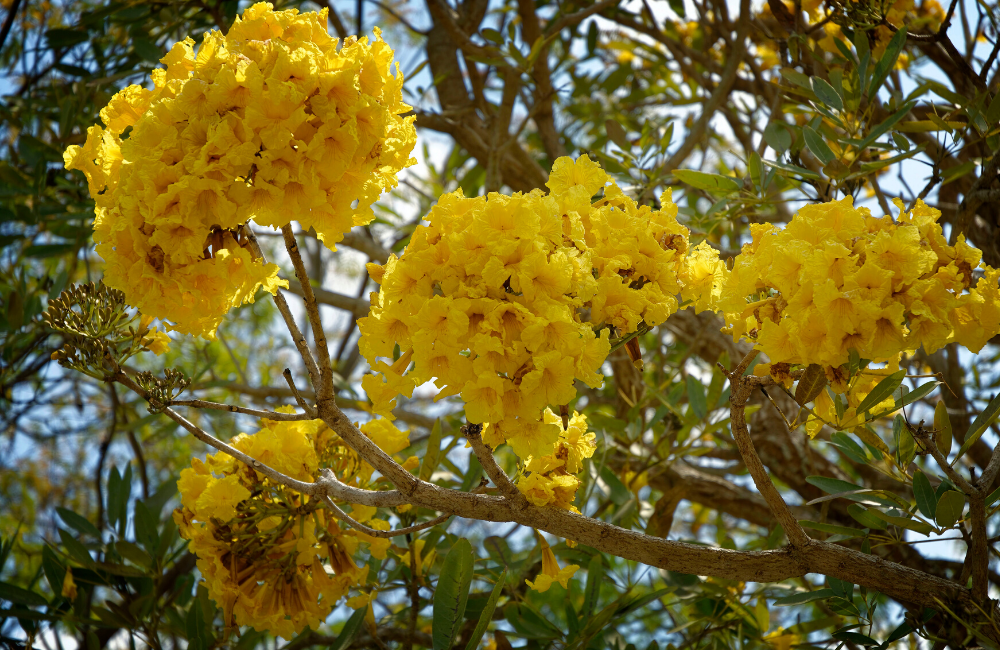
In our last installment of Notes from the Garden, we told you all about flowering vines. Today, we celebrate trees — two showstoppers that provoke lots of stares, photographs, and questions from folks unfamiliar with Southwest Florida’s subtropical landscape.
 Natives of the North, like me, associate yellow with fall. Here, yellow hearkens spring, as the Tabebuia bloom. Tabebuia aurea are commonly called “silver trumpet trees” for the hue of their leaves. But approaching spring, they burst into yellow. Bright, sunshiny yellow, reflecting the season’s near-constant light. There are hundreds of blooms affixed to the end of branches, bunched like bridal bouquets.
Natives of the North, like me, associate yellow with fall. Here, yellow hearkens spring, as the Tabebuia bloom. Tabebuia aurea are commonly called “silver trumpet trees” for the hue of their leaves. But approaching spring, they burst into yellow. Bright, sunshiny yellow, reflecting the season’s near-constant light. There are hundreds of blooms affixed to the end of branches, bunched like bridal bouquets.
In Florida, the trees grow asymmetrically, an alluring feature but also a curious one. Liz Chehayl, the Brian Holley Curator of Collections, wondered about it enough to contact Brazilian agronomist Harri Lorenzi, who has written three books about the trees of Brazil. He told her that they grow symmetrically in the wild. Liz isn’t sure why they behave differently here. Commercial growing practices, perhaps? The soil? Regardless, their incongruity seems to be one of their most alluring attributes.
Watch for these trees throughout Southwest Florida. They’d make a lovely addition to your Instagram feed!
 I’m not sure if publicly declaring woody favorites is akin to choosing a favorite child, but I’m going to do it anyway. I love silk floss trees.
I’m not sure if publicly declaring woody favorites is akin to choosing a favorite child, but I’m going to do it anyway. I love silk floss trees.
In the fall, the silk floss (Ceiba speciosa) wash the landscape in pink. I find myself looking forward to their October spectacle nearly as much as I did the changing of the leaves back in New England. At this time of year, they form avocado-sized seed pods, which dangle perceptively from bare branches. The silk floss is deciduous, meaning it loses its leaves annually.
 Right now, those pods are opening, a few at a time, revealing the tree’s namesake material — tufts of silky fibers. Before the advent of synthetic materials, the silk was used as a stuffing. Now, it’s one of our early spring highlights. Walking near one the other day, I noticed the wind had loosened tufts of silk, which floated on the breeze like wispy puffs.
Right now, those pods are opening, a few at a time, revealing the tree’s namesake material — tufts of silky fibers. Before the advent of synthetic materials, the silk was used as a stuffing. Now, it’s one of our early spring highlights. Walking near one the other day, I noticed the wind had loosened tufts of silk, which floated on the breeze like wispy puffs.
Each tuft, incidentally, holds one pea-sized seed. Silk floss aren’t considered invasive, but they do have a penchant for taking root. When Liz and I examine a mature one near our administrative offices, she points to juveniles on either side, and a sapling she spots nearby, along the pavement. I examine that little one because it shows so well the silk floss’ other famed feature — the spikes.
Yes, for all of its lovely pink and delicate silk, the tree is a menace. A medieval-looking cloak of spikes covers the bark — the more hybridized the tree, the denser the thorns. It’s believed the spikes evolved to keep Amazonian animals from chewing or otherwise damaging young trees. Over time, the thorns shed, and the greenish bark turns gray.
No wonder the silk floss is my favorite. We writers do love complicated characters and things that aren’t what they seem!
Finding a silk floss at this time of year isn’t quite as easy as identifying those trumpet trees. You’ll probably spot the silk before you see the spiky trunk, so be sure to look up and take in all your surroundings. That’s a good lesson for any time of year!
 About the Author
About the Author
Jennifer Reed is the Garden’s Editorial Director and a longtime Southwest Florida journalist.



